Evaluating Project Planning Techniques: Nuclear Plant Project Focus
VerifiedAdded on 2023/06/14
|19
|5130
|282
Report
AI Summary
This report provides an analysis of project planning techniques applicable to a new nuclear plant project. It discusses seven types of project planning techniques, including Agile, Scrum, Kanban, Lean, Waterfall, Six Sigma, and PMI/PMBOK, detailing their appropriate uses, merits, and demerits. The report also explores the availability of project planning software suitable for the project and identifies professional disciplines that can contribute to the nuclear plant project. The aim is to determine the best project planning techniques that can be applied to this particular project, maximizing resource utilization and delivering optimal results within the defined timeframe.
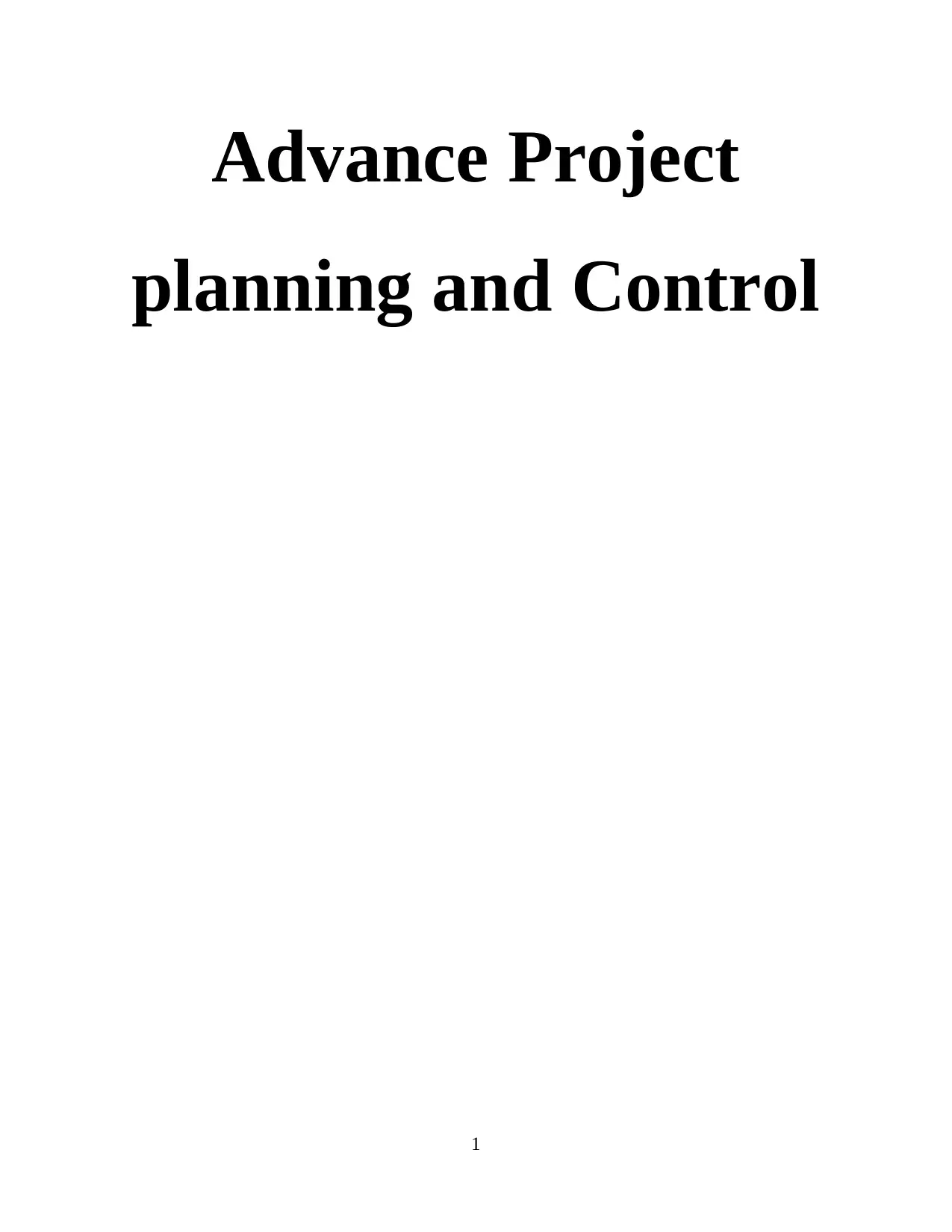
Advance Project
planning and Control
1
planning and Control
1
Paraphrase This Document
Need a fresh take? Get an instant paraphrase of this document with our AI Paraphraser
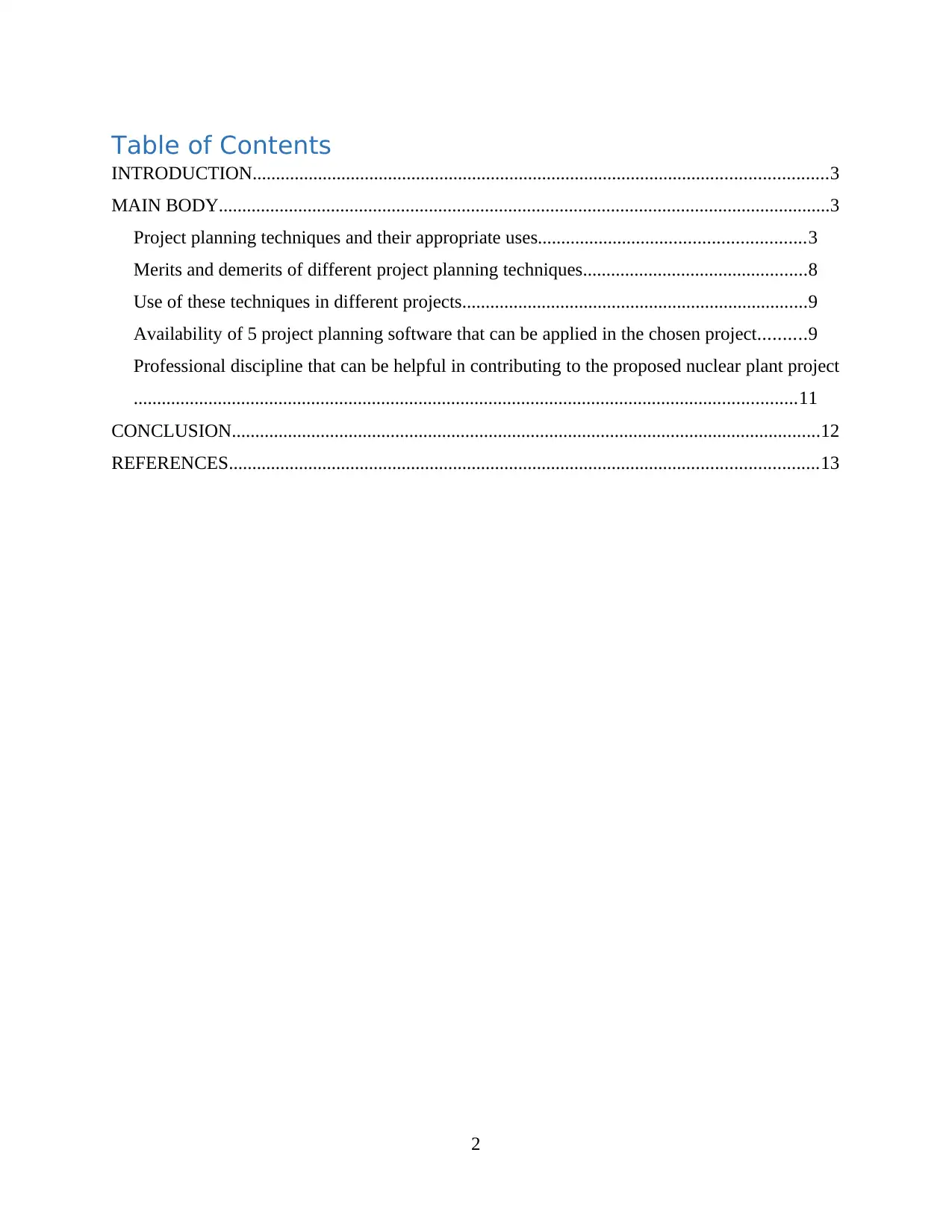
Table of Contents
INTRODUCTION...........................................................................................................................3
MAIN BODY...................................................................................................................................3
Project planning techniques and their appropriate uses.........................................................3
Merits and demerits of different project planning techniques................................................8
Use of these techniques in different projects..........................................................................9
Availability of 5 project planning software that can be applied in the chosen project..........9
Professional discipline that can be helpful in contributing to the proposed nuclear plant project
..............................................................................................................................................11
CONCLUSION..............................................................................................................................12
REFERENCES..............................................................................................................................13
2
INTRODUCTION...........................................................................................................................3
MAIN BODY...................................................................................................................................3
Project planning techniques and their appropriate uses.........................................................3
Merits and demerits of different project planning techniques................................................8
Use of these techniques in different projects..........................................................................9
Availability of 5 project planning software that can be applied in the chosen project..........9
Professional discipline that can be helpful in contributing to the proposed nuclear plant project
..............................................................................................................................................11
CONCLUSION..............................................................................................................................12
REFERENCES..............................................................................................................................13
2
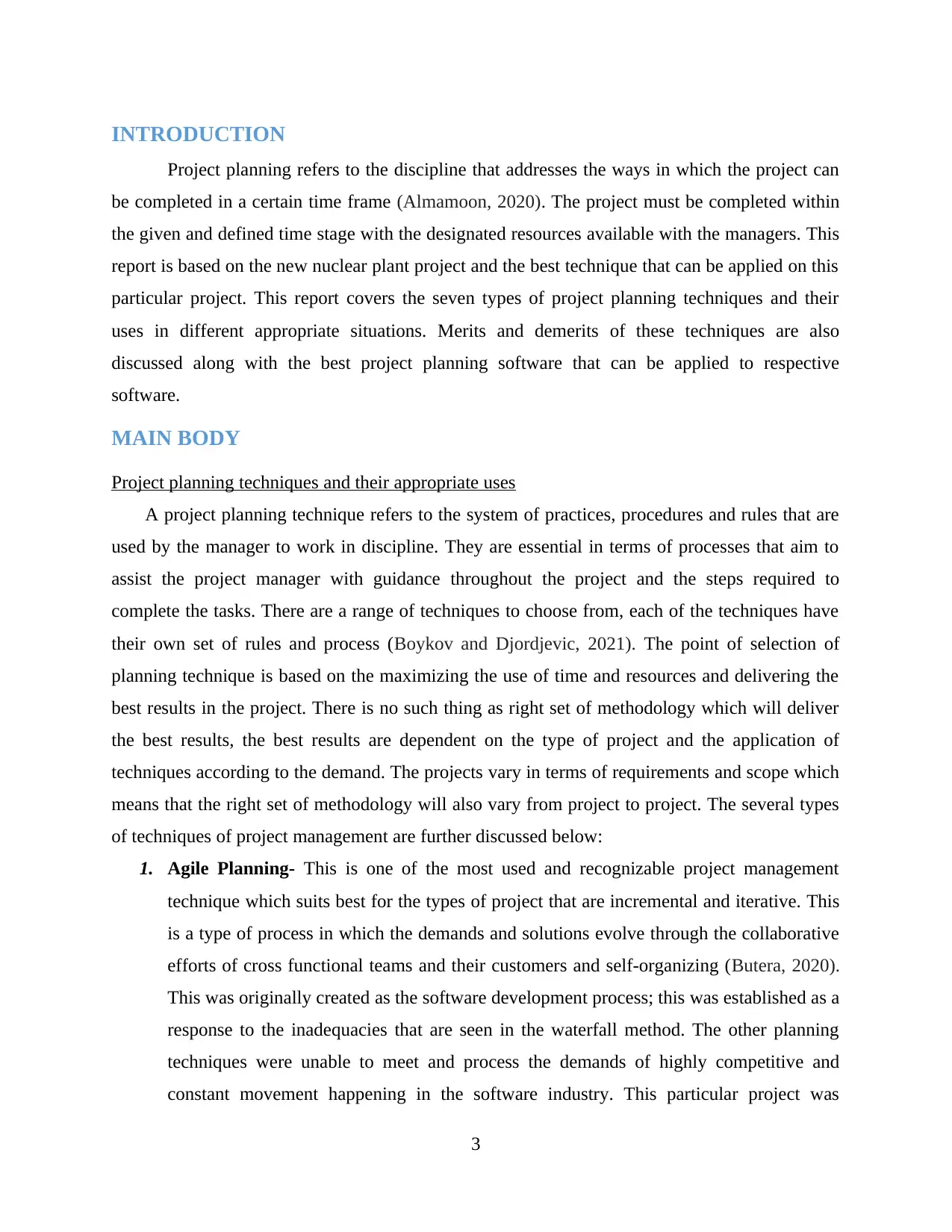
INTRODUCTION
Project planning refers to the discipline that addresses the ways in which the project can
be completed in a certain time frame (Almamoon, 2020). The project must be completed within
the given and defined time stage with the designated resources available with the managers. This
report is based on the new nuclear plant project and the best technique that can be applied on this
particular project. This report covers the seven types of project planning techniques and their
uses in different appropriate situations. Merits and demerits of these techniques are also
discussed along with the best project planning software that can be applied to respective
software.
MAIN BODY
Project planning techniques and their appropriate uses
A project planning technique refers to the system of practices, procedures and rules that are
used by the manager to work in discipline. They are essential in terms of processes that aim to
assist the project manager with guidance throughout the project and the steps required to
complete the tasks. There are a range of techniques to choose from, each of the techniques have
their own set of rules and process (Boykov and Djordjevic, 2021). The point of selection of
planning technique is based on the maximizing the use of time and resources and delivering the
best results in the project. There is no such thing as right set of methodology which will deliver
the best results, the best results are dependent on the type of project and the application of
techniques according to the demand. The projects vary in terms of requirements and scope which
means that the right set of methodology will also vary from project to project. The several types
of techniques of project management are further discussed below:
1. Agile Planning- This is one of the most used and recognizable project management
technique which suits best for the types of project that are incremental and iterative. This
is a type of process in which the demands and solutions evolve through the collaborative
efforts of cross functional teams and their customers and self-organizing (Butera, 2020).
This was originally created as the software development process; this was established as a
response to the inadequacies that are seen in the waterfall method. The other planning
techniques were unable to meet and process the demands of highly competitive and
constant movement happening in the software industry. This particular project was
3
Project planning refers to the discipline that addresses the ways in which the project can
be completed in a certain time frame (Almamoon, 2020). The project must be completed within
the given and defined time stage with the designated resources available with the managers. This
report is based on the new nuclear plant project and the best technique that can be applied on this
particular project. This report covers the seven types of project planning techniques and their
uses in different appropriate situations. Merits and demerits of these techniques are also
discussed along with the best project planning software that can be applied to respective
software.
MAIN BODY
Project planning techniques and their appropriate uses
A project planning technique refers to the system of practices, procedures and rules that are
used by the manager to work in discipline. They are essential in terms of processes that aim to
assist the project manager with guidance throughout the project and the steps required to
complete the tasks. There are a range of techniques to choose from, each of the techniques have
their own set of rules and process (Boykov and Djordjevic, 2021). The point of selection of
planning technique is based on the maximizing the use of time and resources and delivering the
best results in the project. There is no such thing as right set of methodology which will deliver
the best results, the best results are dependent on the type of project and the application of
techniques according to the demand. The projects vary in terms of requirements and scope which
means that the right set of methodology will also vary from project to project. The several types
of techniques of project management are further discussed below:
1. Agile Planning- This is one of the most used and recognizable project management
technique which suits best for the types of project that are incremental and iterative. This
is a type of process in which the demands and solutions evolve through the collaborative
efforts of cross functional teams and their customers and self-organizing (Butera, 2020).
This was originally created as the software development process; this was established as a
response to the inadequacies that are seen in the waterfall method. The other planning
techniques were unable to meet and process the demands of highly competitive and
constant movement happening in the software industry. This particular project was
3
⊘ This is a preview!⊘
Do you want full access?
Subscribe today to unlock all pages.

Trusted by 1+ million students worldwide
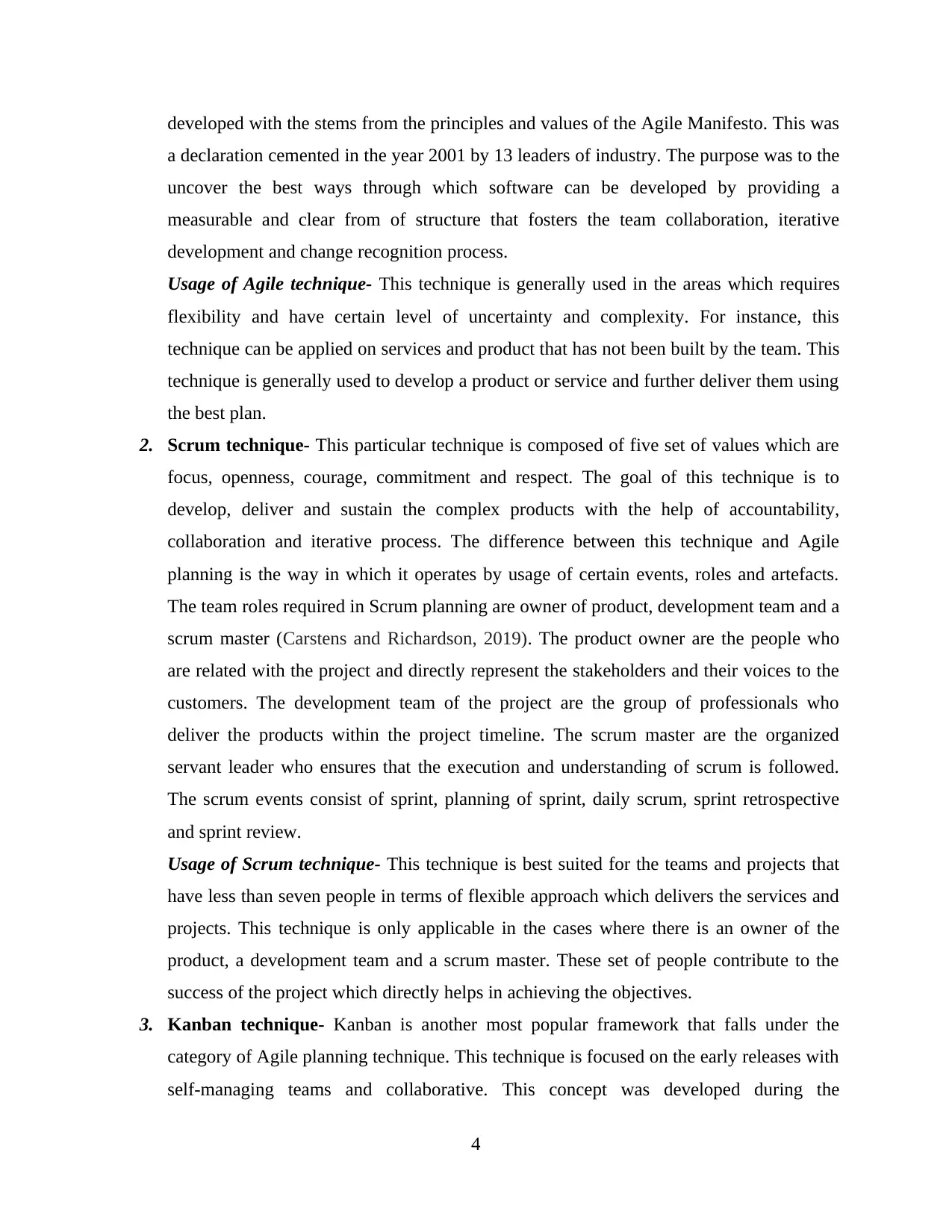
developed with the stems from the principles and values of the Agile Manifesto. This was
a declaration cemented in the year 2001 by 13 leaders of industry. The purpose was to the
uncover the best ways through which software can be developed by providing a
measurable and clear from of structure that fosters the team collaboration, iterative
development and change recognition process.
Usage of Agile technique- This technique is generally used in the areas which requires
flexibility and have certain level of uncertainty and complexity. For instance, this
technique can be applied on services and product that has not been built by the team. This
technique is generally used to develop a product or service and further deliver them using
the best plan.
2. Scrum technique- This particular technique is composed of five set of values which are
focus, openness, courage, commitment and respect. The goal of this technique is to
develop, deliver and sustain the complex products with the help of accountability,
collaboration and iterative process. The difference between this technique and Agile
planning is the way in which it operates by usage of certain events, roles and artefacts.
The team roles required in Scrum planning are owner of product, development team and a
scrum master (Carstens and Richardson, 2019). The product owner are the people who
are related with the project and directly represent the stakeholders and their voices to the
customers. The development team of the project are the group of professionals who
deliver the products within the project timeline. The scrum master are the organized
servant leader who ensures that the execution and understanding of scrum is followed.
The scrum events consist of sprint, planning of sprint, daily scrum, sprint retrospective
and sprint review.
Usage of Scrum technique- This technique is best suited for the teams and projects that
have less than seven people in terms of flexible approach which delivers the services and
projects. This technique is only applicable in the cases where there is an owner of the
product, a development team and a scrum master. These set of people contribute to the
success of the project which directly helps in achieving the objectives.
3. Kanban technique- Kanban is another most popular framework that falls under the
category of Agile planning technique. This technique is focused on the early releases with
self-managing teams and collaborative. This concept was developed during the
4
a declaration cemented in the year 2001 by 13 leaders of industry. The purpose was to the
uncover the best ways through which software can be developed by providing a
measurable and clear from of structure that fosters the team collaboration, iterative
development and change recognition process.
Usage of Agile technique- This technique is generally used in the areas which requires
flexibility and have certain level of uncertainty and complexity. For instance, this
technique can be applied on services and product that has not been built by the team. This
technique is generally used to develop a product or service and further deliver them using
the best plan.
2. Scrum technique- This particular technique is composed of five set of values which are
focus, openness, courage, commitment and respect. The goal of this technique is to
develop, deliver and sustain the complex products with the help of accountability,
collaboration and iterative process. The difference between this technique and Agile
planning is the way in which it operates by usage of certain events, roles and artefacts.
The team roles required in Scrum planning are owner of product, development team and a
scrum master (Carstens and Richardson, 2019). The product owner are the people who
are related with the project and directly represent the stakeholders and their voices to the
customers. The development team of the project are the group of professionals who
deliver the products within the project timeline. The scrum master are the organized
servant leader who ensures that the execution and understanding of scrum is followed.
The scrum events consist of sprint, planning of sprint, daily scrum, sprint retrospective
and sprint review.
Usage of Scrum technique- This technique is best suited for the teams and projects that
have less than seven people in terms of flexible approach which delivers the services and
projects. This technique is only applicable in the cases where there is an owner of the
product, a development team and a scrum master. These set of people contribute to the
success of the project which directly helps in achieving the objectives.
3. Kanban technique- Kanban is another most popular framework that falls under the
category of Agile planning technique. This technique is focused on the early releases with
self-managing teams and collaborative. This concept was developed during the
4
Paraphrase This Document
Need a fresh take? Get an instant paraphrase of this document with our AI Paraphraser

production line of Toyota factories in the year 1940s, this was a visual method that aimed
to deliver the high quality results by painting a picture of the flow of work and the
process which will help in identification of bottlenecks in the early stage of development
process. This technique is generally operated on six set of general practices which help in
clearly setting up the planning process. The six set of general practices in this technique
are visualization, Limiting work of the progress, flow management, making policies
explicit, making up of policies explicit, using of feedback loops and further using
collaborative or experimental evolution. The Kanban technique of planning is highly
helpful in terms of achieving efficiency by usage of visual cues that helps in terms of
signalling the various stages of the process of development. There are a range of cues that
are involved in the process are Kanban board, Kanban cards and Kanban swim lanes for
those who are looking for extra bit of the organisation.
Usage of Kanban techniques- The Kanban technique is most helpful for the software
development industry as it directly helps in terms deciding the framework. The flexibility
in this technique is helpful in bringing more and more traction in the project management
industry. This technique is best suited for the project with smaller set of teams. This is a
great technique which can be used for the personal productivity purposes.
4. Lean techniques- Lean methodology is helpful in promoting the maximum customer
value which helps in minimizing the waste and increasing the productivity. This
technique aims to create and deliver more values which will help in terms of bringing the
best results. This technique is stemmed from the Japanese manufacturing industry which
supposes that the waste must be eliminated (Cooray et. al., 2018). Quality improves the
production time and cost gets reduced which directly contributes to the process of
increased productivity. Through lean planning technique, three types of waste are
identified that are muda, mura and muri. These wastes are also known as 3Ms and these
Ms are identified on the basis of the project on which the manager is working. Muda
refers to the elimination of wastage and further refers to the identification of activity and
process that does not contribute to the overall process and values. This is eliminated as it
is complete wastage of time and resources due to which the organization is unable to add
value to the project. Mura refers to the elimination of variances that exist in the process of
workflow process at a operation and scheduling level which helps in smooth flow of
5
to deliver the high quality results by painting a picture of the flow of work and the
process which will help in identification of bottlenecks in the early stage of development
process. This technique is generally operated on six set of general practices which help in
clearly setting up the planning process. The six set of general practices in this technique
are visualization, Limiting work of the progress, flow management, making policies
explicit, making up of policies explicit, using of feedback loops and further using
collaborative or experimental evolution. The Kanban technique of planning is highly
helpful in terms of achieving efficiency by usage of visual cues that helps in terms of
signalling the various stages of the process of development. There are a range of cues that
are involved in the process are Kanban board, Kanban cards and Kanban swim lanes for
those who are looking for extra bit of the organisation.
Usage of Kanban techniques- The Kanban technique is most helpful for the software
development industry as it directly helps in terms deciding the framework. The flexibility
in this technique is helpful in bringing more and more traction in the project management
industry. This technique is best suited for the project with smaller set of teams. This is a
great technique which can be used for the personal productivity purposes.
4. Lean techniques- Lean methodology is helpful in promoting the maximum customer
value which helps in minimizing the waste and increasing the productivity. This
technique aims to create and deliver more values which will help in terms of bringing the
best results. This technique is stemmed from the Japanese manufacturing industry which
supposes that the waste must be eliminated (Cooray et. al., 2018). Quality improves the
production time and cost gets reduced which directly contributes to the process of
increased productivity. Through lean planning technique, three types of waste are
identified that are muda, mura and muri. These wastes are also known as 3Ms and these
Ms are identified on the basis of the project on which the manager is working. Muda
refers to the elimination of wastage and further refers to the identification of activity and
process that does not contribute to the overall process and values. This is eliminated as it
is complete wastage of time and resources due to which the organization is unable to add
value to the project. Mura refers to the elimination of variances that exist in the process of
workflow process at a operation and scheduling level which helps in smooth flow of
5
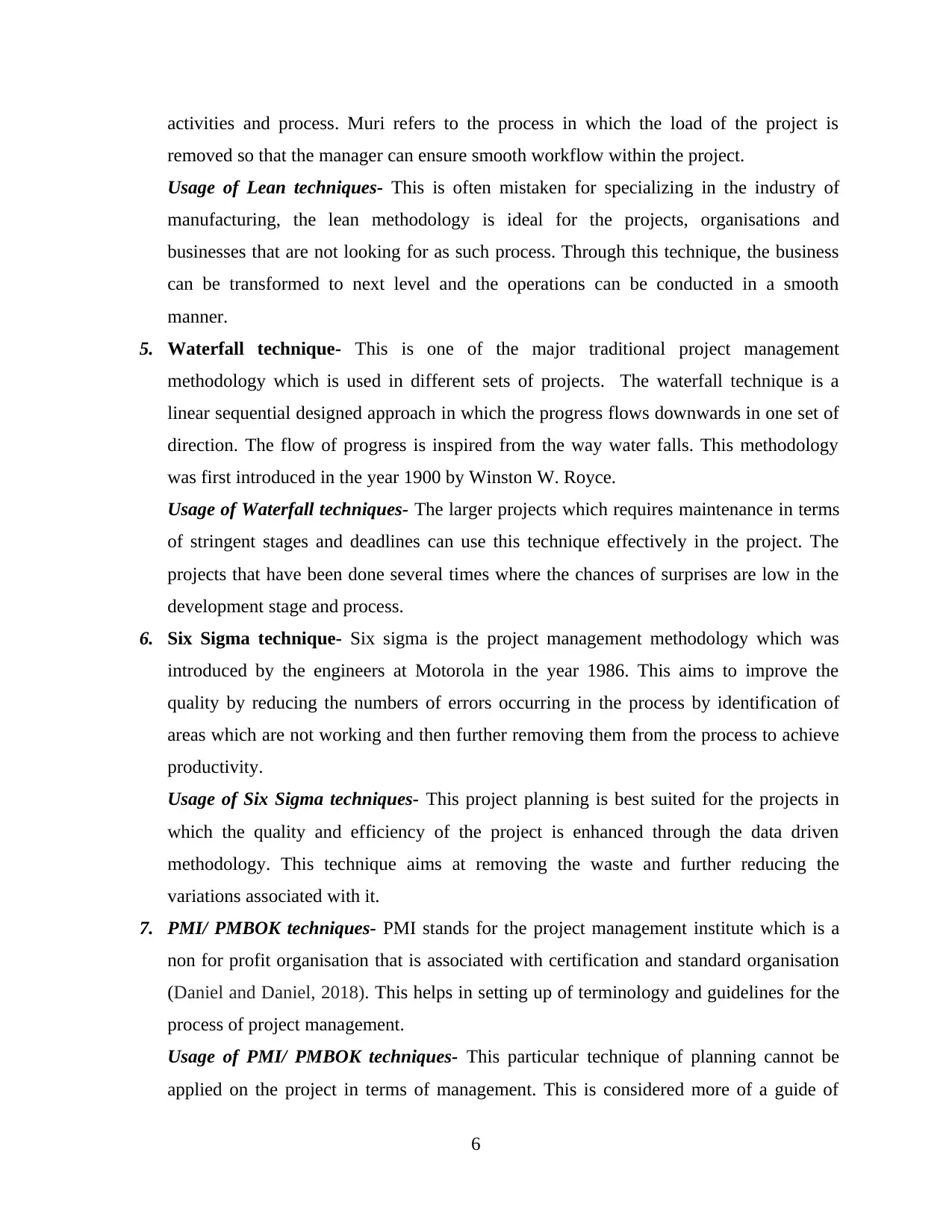
activities and process. Muri refers to the process in which the load of the project is
removed so that the manager can ensure smooth workflow within the project.
Usage of Lean techniques- This is often mistaken for specializing in the industry of
manufacturing, the lean methodology is ideal for the projects, organisations and
businesses that are not looking for as such process. Through this technique, the business
can be transformed to next level and the operations can be conducted in a smooth
manner.
5. Waterfall technique- This is one of the major traditional project management
methodology which is used in different sets of projects. The waterfall technique is a
linear sequential designed approach in which the progress flows downwards in one set of
direction. The flow of progress is inspired from the way water falls. This methodology
was first introduced in the year 1900 by Winston W. Royce.
Usage of Waterfall techniques- The larger projects which requires maintenance in terms
of stringent stages and deadlines can use this technique effectively in the project. The
projects that have been done several times where the chances of surprises are low in the
development stage and process.
6. Six Sigma technique- Six sigma is the project management methodology which was
introduced by the engineers at Motorola in the year 1986. This aims to improve the
quality by reducing the numbers of errors occurring in the process by identification of
areas which are not working and then further removing them from the process to achieve
productivity.
Usage of Six Sigma techniques- This project planning is best suited for the projects in
which the quality and efficiency of the project is enhanced through the data driven
methodology. This technique aims at removing the waste and further reducing the
variations associated with it.
7. PMI/ PMBOK techniques- PMI stands for the project management institute which is a
non for profit organisation that is associated with certification and standard organisation
(Daniel and Daniel, 2018). This helps in setting up of terminology and guidelines for the
process of project management.
Usage of PMI/ PMBOK techniques- This particular technique of planning cannot be
applied on the project in terms of management. This is considered more of a guide of
6
removed so that the manager can ensure smooth workflow within the project.
Usage of Lean techniques- This is often mistaken for specializing in the industry of
manufacturing, the lean methodology is ideal for the projects, organisations and
businesses that are not looking for as such process. Through this technique, the business
can be transformed to next level and the operations can be conducted in a smooth
manner.
5. Waterfall technique- This is one of the major traditional project management
methodology which is used in different sets of projects. The waterfall technique is a
linear sequential designed approach in which the progress flows downwards in one set of
direction. The flow of progress is inspired from the way water falls. This methodology
was first introduced in the year 1900 by Winston W. Royce.
Usage of Waterfall techniques- The larger projects which requires maintenance in terms
of stringent stages and deadlines can use this technique effectively in the project. The
projects that have been done several times where the chances of surprises are low in the
development stage and process.
6. Six Sigma technique- Six sigma is the project management methodology which was
introduced by the engineers at Motorola in the year 1986. This aims to improve the
quality by reducing the numbers of errors occurring in the process by identification of
areas which are not working and then further removing them from the process to achieve
productivity.
Usage of Six Sigma techniques- This project planning is best suited for the projects in
which the quality and efficiency of the project is enhanced through the data driven
methodology. This technique aims at removing the waste and further reducing the
variations associated with it.
7. PMI/ PMBOK techniques- PMI stands for the project management institute which is a
non for profit organisation that is associated with certification and standard organisation
(Daniel and Daniel, 2018). This helps in setting up of terminology and guidelines for the
process of project management.
Usage of PMI/ PMBOK techniques- This particular technique of planning cannot be
applied on the project in terms of management. This is considered more of a guide of
6
⊘ This is a preview!⊘
Do you want full access?
Subscribe today to unlock all pages.

Trusted by 1+ million students worldwide
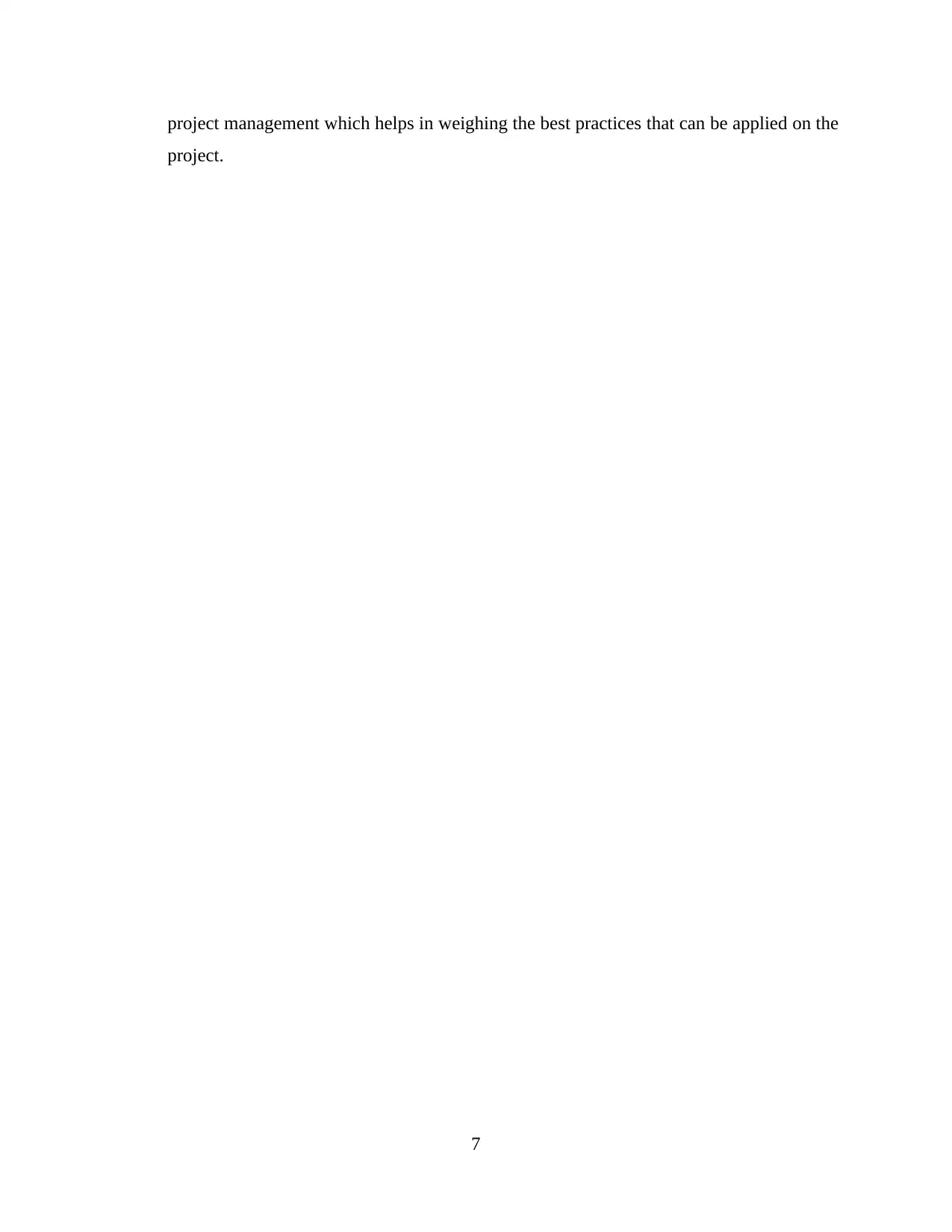
project management which helps in weighing the best practices that can be applied on the
project.
7
project.
7
Paraphrase This Document
Need a fresh take? Get an instant paraphrase of this document with our AI Paraphraser
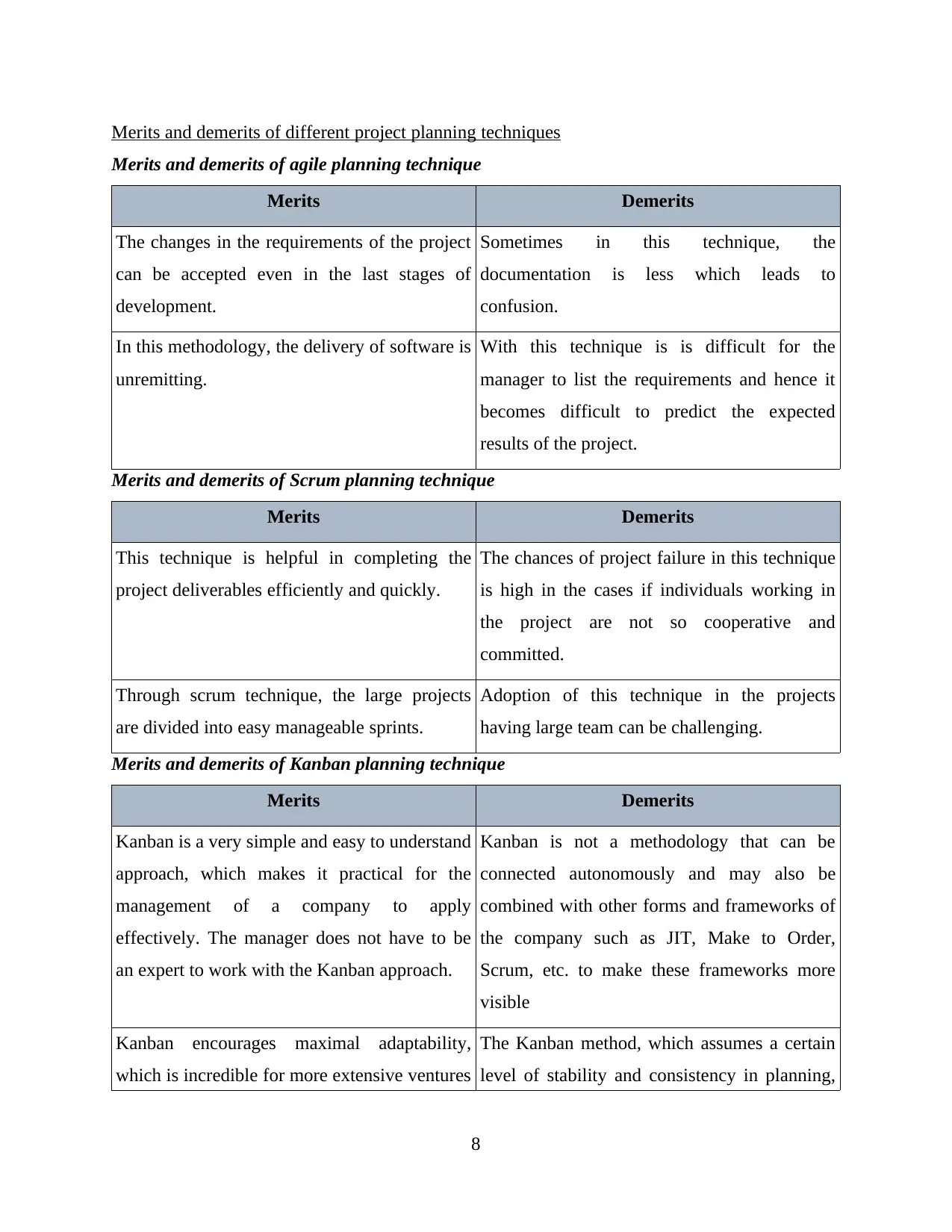
Merits and demerits of different project planning techniques
Merits and demerits of agile planning technique
Merits Demerits
The changes in the requirements of the project
can be accepted even in the last stages of
development.
Sometimes in this technique, the
documentation is less which leads to
confusion.
In this methodology, the delivery of software is
unremitting.
With this technique is is difficult for the
manager to list the requirements and hence it
becomes difficult to predict the expected
results of the project.
Merits and demerits of Scrum planning technique
Merits Demerits
This technique is helpful in completing the
project deliverables efficiently and quickly.
The chances of project failure in this technique
is high in the cases if individuals working in
the project are not so cooperative and
committed.
Through scrum technique, the large projects
are divided into easy manageable sprints.
Adoption of this technique in the projects
having large team can be challenging.
Merits and demerits of Kanban planning technique
Merits Demerits
Kanban is a very simple and easy to understand
approach, which makes it practical for the
management of a company to apply
effectively. The manager does not have to be
an expert to work with the Kanban approach.
Kanban is not a methodology that can be
connected autonomously and may also be
combined with other forms and frameworks of
the company such as JIT, Make to Order,
Scrum, etc. to make these frameworks more
visible
Kanban encourages maximal adaptability,
which is incredible for more extensive ventures
The Kanban method, which assumes a certain
level of stability and consistency in planning,
8
Merits and demerits of agile planning technique
Merits Demerits
The changes in the requirements of the project
can be accepted even in the last stages of
development.
Sometimes in this technique, the
documentation is less which leads to
confusion.
In this methodology, the delivery of software is
unremitting.
With this technique is is difficult for the
manager to list the requirements and hence it
becomes difficult to predict the expected
results of the project.
Merits and demerits of Scrum planning technique
Merits Demerits
This technique is helpful in completing the
project deliverables efficiently and quickly.
The chances of project failure in this technique
is high in the cases if individuals working in
the project are not so cooperative and
committed.
Through scrum technique, the large projects
are divided into easy manageable sprints.
Adoption of this technique in the projects
having large team can be challenging.
Merits and demerits of Kanban planning technique
Merits Demerits
Kanban is a very simple and easy to understand
approach, which makes it practical for the
management of a company to apply
effectively. The manager does not have to be
an expert to work with the Kanban approach.
Kanban is not a methodology that can be
connected autonomously and may also be
combined with other forms and frameworks of
the company such as JIT, Make to Order,
Scrum, etc. to make these frameworks more
visible
Kanban encourages maximal adaptability,
which is incredible for more extensive ventures
The Kanban method, which assumes a certain
level of stability and consistency in planning,
8
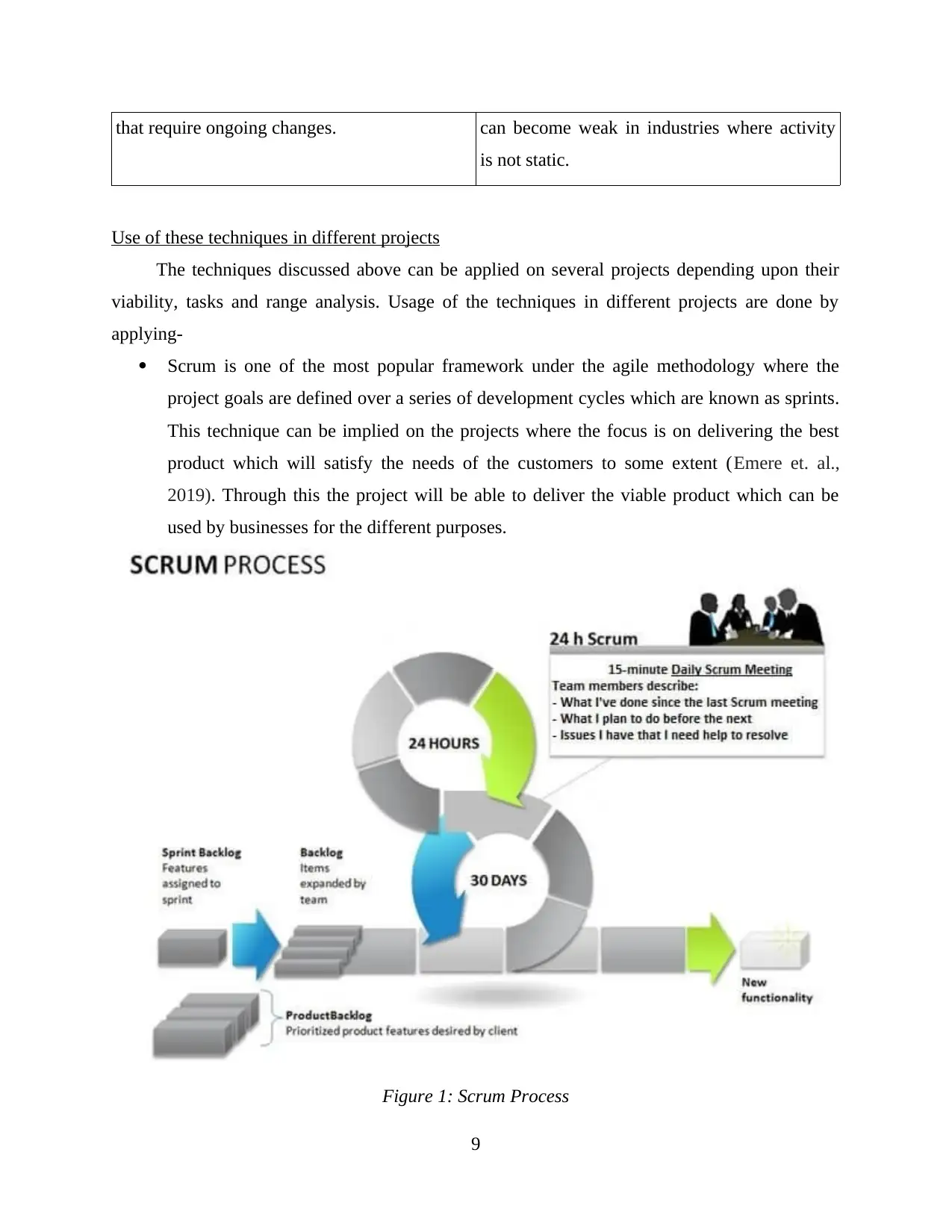
that require ongoing changes. can become weak in industries where activity
is not static.
Use of these techniques in different projects
The techniques discussed above can be applied on several projects depending upon their
viability, tasks and range analysis. Usage of the techniques in different projects are done by
applying-
Scrum is one of the most popular framework under the agile methodology where the
project goals are defined over a series of development cycles which are known as sprints.
This technique can be implied on the projects where the focus is on delivering the best
product which will satisfy the needs of the customers to some extent (Emere et. al.,
2019). Through this the project will be able to deliver the viable product which can be
used by businesses for the different purposes.
Figure 1: Scrum Process
9
is not static.
Use of these techniques in different projects
The techniques discussed above can be applied on several projects depending upon their
viability, tasks and range analysis. Usage of the techniques in different projects are done by
applying-
Scrum is one of the most popular framework under the agile methodology where the
project goals are defined over a series of development cycles which are known as sprints.
This technique can be implied on the projects where the focus is on delivering the best
product which will satisfy the needs of the customers to some extent (Emere et. al.,
2019). Through this the project will be able to deliver the viable product which can be
used by businesses for the different purposes.
Figure 1: Scrum Process
9
⊘ This is a preview!⊘
Do you want full access?
Subscribe today to unlock all pages.

Trusted by 1+ million students worldwide

Kanban is applied on the workflow of the projects to break down the large tasks into
smaller ones. This tasks helps in organising and displaying so that everyone on the
project team gets updated about the progress of project. This will directly help in terms of
increasing the growth prospects of the project. This can be used on the projects where the
process and the tasks are large and it needs to be simplified and break down to further
effectively proceed with it. This can only be developed in cases where there is a scope of
breaking down the tasks and allocating the same tasks to the users of the project.
Figure 2: Standard Kanban board process
Agile planning technique is different from the general process, the way in which it is
different is further described below with the help of diagram:
10
smaller ones. This tasks helps in organising and displaying so that everyone on the
project team gets updated about the progress of project. This will directly help in terms of
increasing the growth prospects of the project. This can be used on the projects where the
process and the tasks are large and it needs to be simplified and break down to further
effectively proceed with it. This can only be developed in cases where there is a scope of
breaking down the tasks and allocating the same tasks to the users of the project.
Figure 2: Standard Kanban board process
Agile planning technique is different from the general process, the way in which it is
different is further described below with the help of diagram:
10
Paraphrase This Document
Need a fresh take? Get an instant paraphrase of this document with our AI Paraphraser
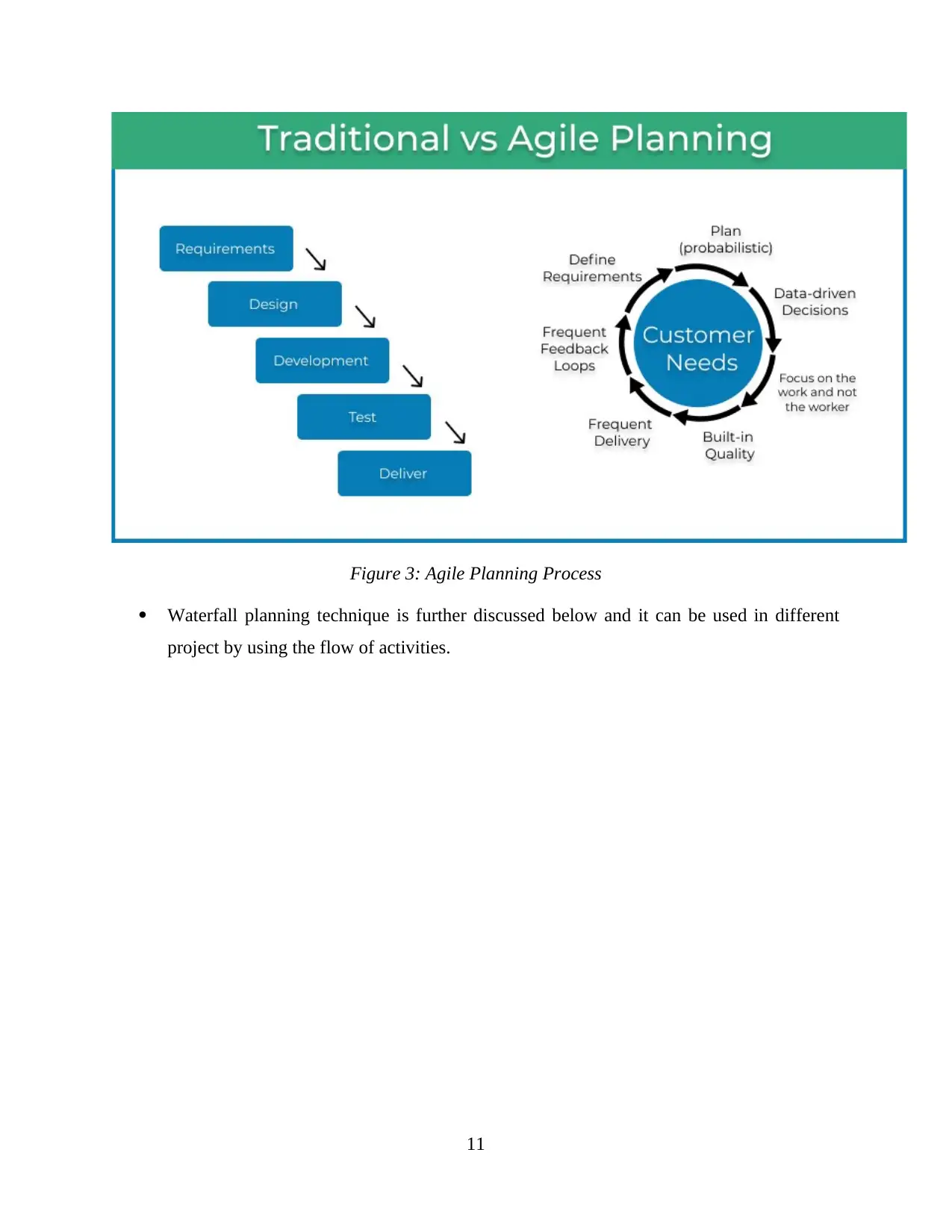
Figure 3: Agile Planning Process
Waterfall planning technique is further discussed below and it can be used in different
project by using the flow of activities.
11
Waterfall planning technique is further discussed below and it can be used in different
project by using the flow of activities.
11
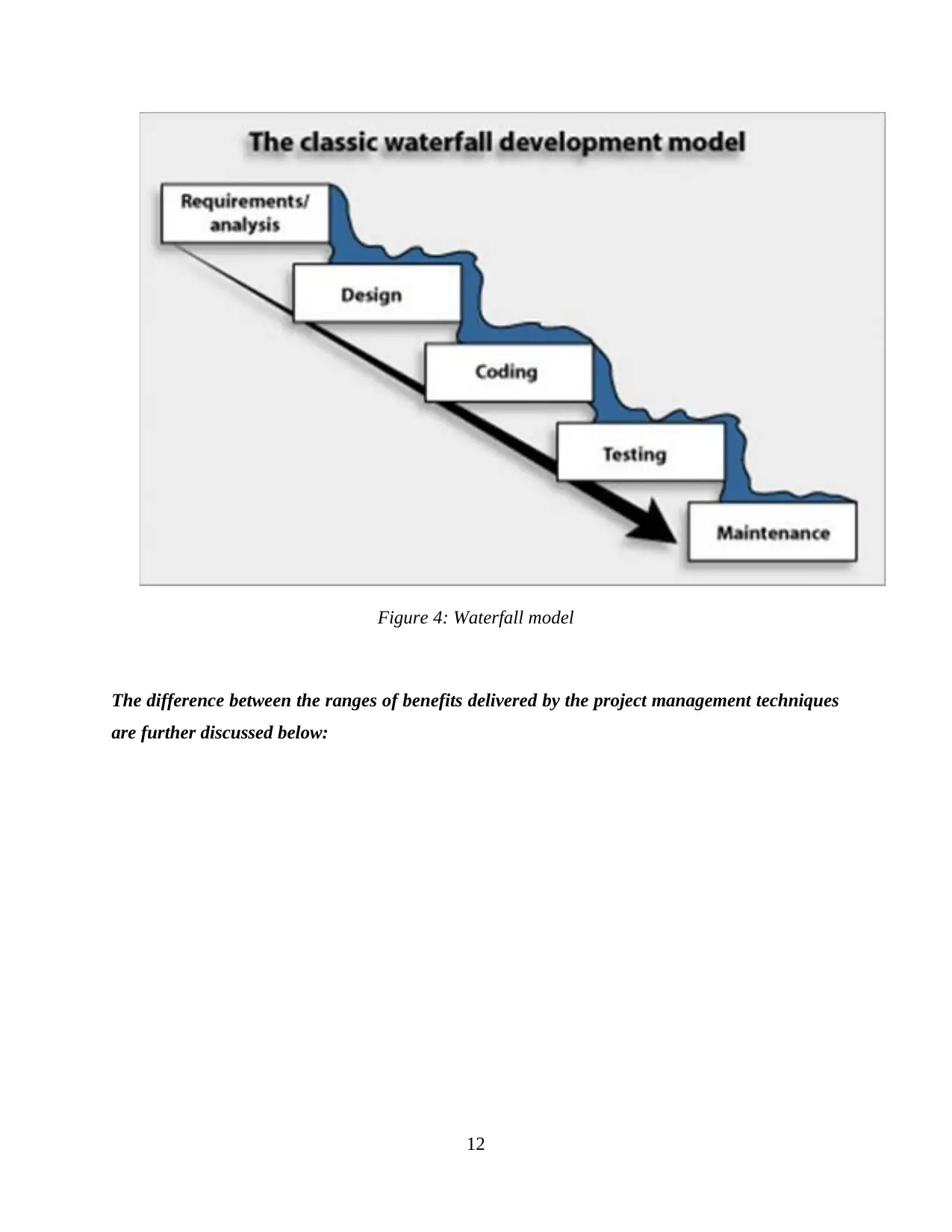
Figure 4: Waterfall model
The difference between the ranges of benefits delivered by the project management techniques
are further discussed below:
12
The difference between the ranges of benefits delivered by the project management techniques
are further discussed below:
12
⊘ This is a preview!⊘
Do you want full access?
Subscribe today to unlock all pages.

Trusted by 1+ million students worldwide
1 out of 19
Related Documents
Your All-in-One AI-Powered Toolkit for Academic Success.
+13062052269
info@desklib.com
Available 24*7 on WhatsApp / Email
![[object Object]](/_next/static/media/star-bottom.7253800d.svg)
Unlock your academic potential
Copyright © 2020–2025 A2Z Services. All Rights Reserved. Developed and managed by ZUCOL.




